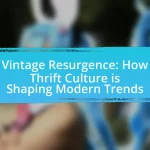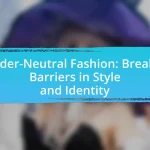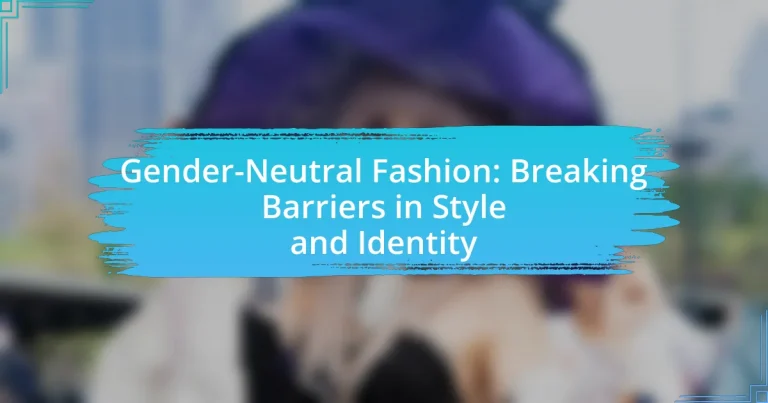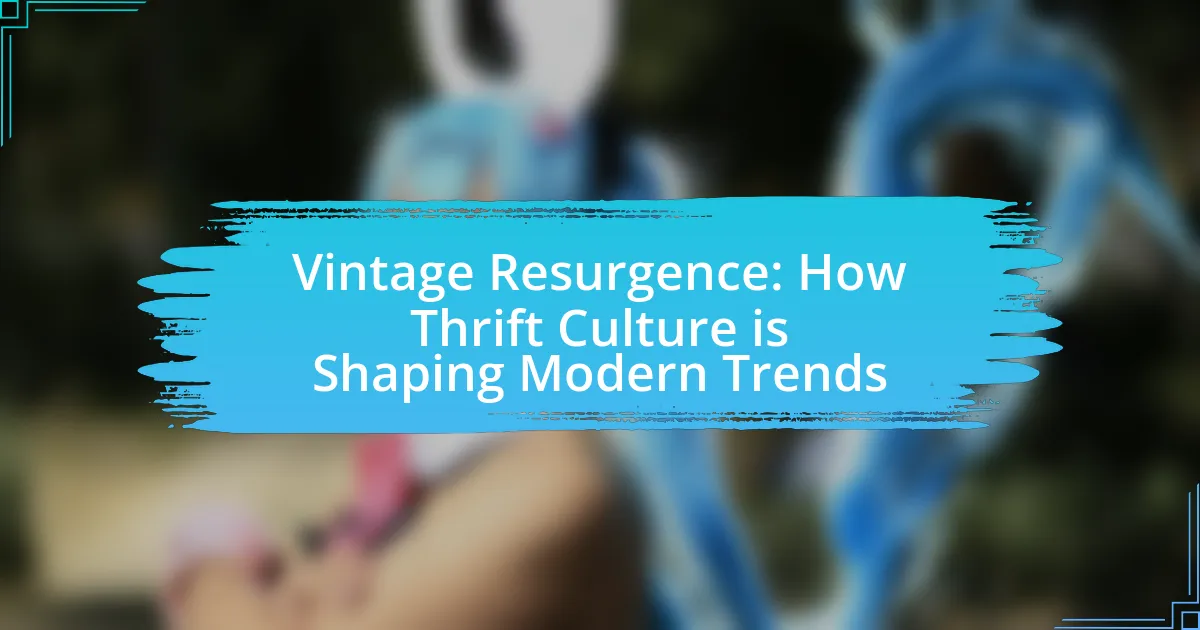Gender-neutral fashion is a clothing movement designed to be inclusive, allowing individuals to express their identity without being confined to traditional gender norms. This article explores the characteristics that differentiate gender-neutral fashion from traditional styles, the historical influences that have shaped its evolution, and the cultural shifts driving its acceptance in contemporary society. It also examines the role of fashion icons, the challenges faced by designers, and the emerging trends within this movement, including sustainability and technological innovations. Additionally, the article highlights consumer responses and preferences, providing practical tips for building a versatile gender-neutral wardrobe.

What is Gender-Neutral Fashion?
Gender-neutral fashion refers to clothing designed to be worn by individuals regardless of their gender identity, promoting inclusivity and breaking traditional gender norms. This fashion movement emphasizes styles that are not specifically tailored for men or women, allowing for a more fluid expression of identity. The rise of gender-neutral fashion has been supported by cultural shifts towards acceptance of diverse gender identities, with brands like Telfar and Rad Hourani leading the way in creating unisex collections that cater to a broader audience.
How does Gender-Neutral Fashion differ from traditional fashion?
Gender-neutral fashion differs from traditional fashion primarily in its rejection of gender-specific clothing categories. Traditional fashion typically adheres to binary gender norms, offering distinct styles for men and women, while gender-neutral fashion promotes inclusivity by designing garments that can be worn by anyone, regardless of gender identity. This approach is supported by the increasing demand for clothing that reflects diverse identities, as evidenced by a 2021 report from the Council of Fashion Designers of America, which highlighted a growing trend towards unisex collections in response to societal shifts in understanding gender.
What are the key characteristics of Gender-Neutral Fashion?
Gender-neutral fashion is characterized by its inclusivity, versatility, and lack of gender-specific design elements. This style transcends traditional gender norms by offering clothing that can be worn by anyone, regardless of their gender identity. Key features include unisex silhouettes, neutral color palettes, and the use of materials that prioritize comfort and functionality over gendered aesthetics. For instance, many brands now create collections that feature oversized fits and adaptable designs, allowing for a broader range of body types and personal expressions. The rise of gender-neutral fashion reflects a cultural shift towards acceptance and diversity in personal identity, as evidenced by the increasing number of fashion shows and campaigns that promote non-binary and gender-fluid models.
Why is Gender-Neutral Fashion important in today’s society?
Gender-neutral fashion is important in today’s society because it promotes inclusivity and challenges traditional gender norms. This fashion movement allows individuals to express their identity without being confined to binary gender categories, fostering a sense of belonging for diverse gender identities. According to a 2021 report by McKinsey & Company, 67% of Gen Z consumers prefer brands that reflect their values, including inclusivity and diversity, highlighting the demand for gender-neutral options in the marketplace. By embracing gender-neutral fashion, society can create a more accepting environment that values personal expression over rigid gender expectations.
What historical influences have shaped Gender-Neutral Fashion?
Gender-neutral fashion has been shaped by various historical influences, including the feminist movement, androgynous styles of the 1960s and 1970s, and the rise of LGBTQ+ visibility. The feminist movement challenged traditional gender roles, promoting clothing that allowed women to adopt styles previously reserved for men, such as trousers and tailored suits. In the 1960s and 1970s, designers like Yves Saint Laurent popularized androgynous looks, exemplified by the “Le Smoking” tuxedo for women, which blurred gender lines in fashion. Additionally, the increasing visibility of LGBTQ+ communities has fostered a cultural shift towards inclusivity in fashion, encouraging designers to create collections that defy binary gender norms. These historical influences collectively contributed to the emergence and acceptance of gender-neutral fashion in contemporary society.
How have cultural shifts impacted the evolution of Gender-Neutral Fashion?
Cultural shifts have significantly influenced the evolution of gender-neutral fashion by challenging traditional gender norms and promoting inclusivity. The rise of movements advocating for LGBTQ+ rights and gender equality has led to a broader acceptance of non-binary identities, which in turn has encouraged designers to create clothing that transcends conventional gender categories. For instance, the increasing visibility of gender-fluid celebrities and influencers has popularized styles that defy binary classifications, leading to a surge in brands offering unisex collections. According to a 2021 report by McKinsey & Company, the global market for gender-neutral fashion is projected to grow as consumers increasingly seek brands that reflect their values of diversity and self-expression. This cultural shift towards acceptance and representation has fundamentally reshaped the fashion landscape, making gender-neutral options more mainstream and accessible.
What role have fashion icons played in promoting Gender-Neutral Fashion?
Fashion icons have played a pivotal role in promoting gender-neutral fashion by challenging traditional gender norms and showcasing inclusive styles. Through their visibility and influence, these icons have normalized the idea that clothing does not have to be confined to binary gender categories. For instance, celebrities like Billy Porter and Jaden Smith have publicly embraced gender-fluid attire, which has sparked conversations around inclusivity in fashion. Their choices have led to increased representation of non-binary and gender-neutral designs on runways and in mainstream retail, thereby validating and encouraging a broader acceptance of diverse gender expressions in fashion.
What are the challenges faced by Gender-Neutral Fashion?
Gender-neutral fashion faces several challenges, including societal norms, market demand, and sizing issues. Societal norms often dictate traditional gender roles, making it difficult for consumers to embrace gender-neutral options. Market demand is another challenge, as many retailers may hesitate to invest in gender-neutral lines due to perceived limited consumer interest. Additionally, sizing issues arise because gender-neutral clothing must accommodate a wider range of body types, complicating production and inventory management. These challenges hinder the growth and acceptance of gender-neutral fashion in the mainstream market.
How do societal norms affect the acceptance of Gender-Neutral Fashion?
Societal norms significantly influence the acceptance of gender-neutral fashion by shaping perceptions of gender roles and expectations. These norms often dictate what is considered appropriate attire for different genders, leading to resistance against styles that blur traditional boundaries. For instance, a study published in the Journal of Fashion Marketing and Management found that individuals who adhere strongly to conventional gender norms are less likely to embrace gender-neutral clothing options. This resistance can manifest in social stigma or criticism, which discourages individuals from adopting such styles. Conversely, as societal attitudes evolve towards inclusivity and diversity, acceptance of gender-neutral fashion increases, reflecting a broader cultural shift towards challenging rigid gender binaries.
What barriers do designers encounter when creating Gender-Neutral collections?
Designers encounter several barriers when creating gender-neutral collections, primarily including societal norms, market demand, and sizing challenges. Societal norms often dictate traditional gender roles in fashion, leading to resistance from consumers who may prefer conventional gendered clothing. Market demand can be limited, as many retailers prioritize gender-specific lines due to perceived profitability, which discourages investment in gender-neutral options. Additionally, sizing challenges arise because gender-neutral collections must accommodate a wider range of body types, complicating production and inventory management. These barriers collectively hinder the widespread adoption and success of gender-neutral fashion in the industry.
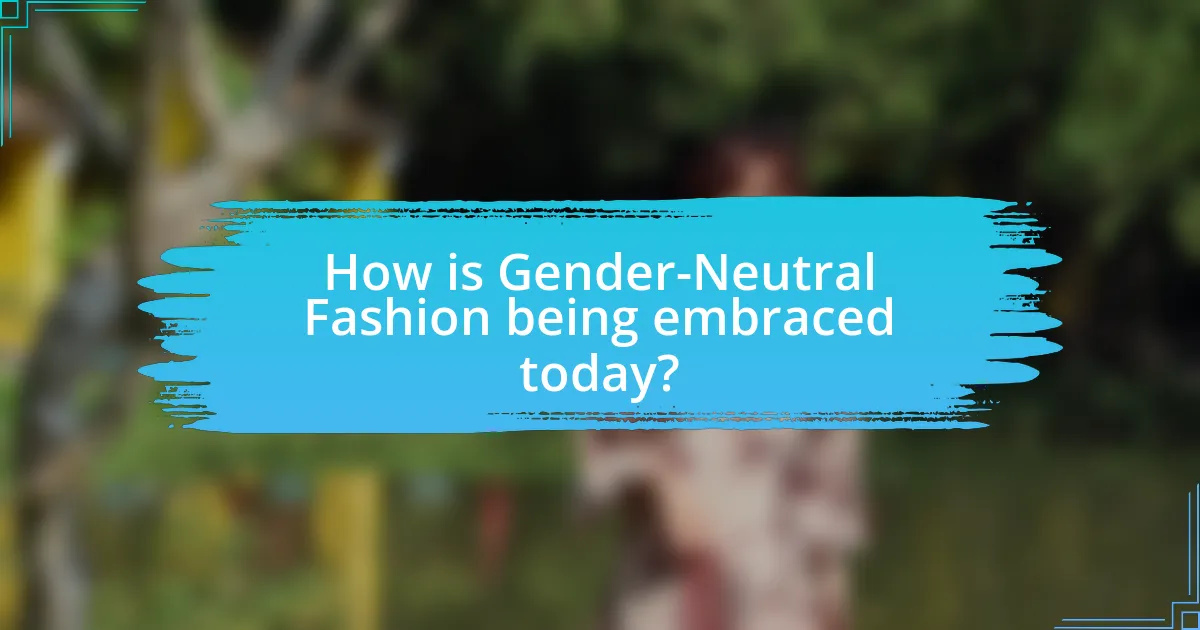
How is Gender-Neutral Fashion being embraced today?
Gender-neutral fashion is being embraced today through a significant shift in consumer preferences and the fashion industry’s response to inclusivity. Major brands like Gucci and Zara have introduced unisex collections, reflecting a growing demand for clothing that transcends traditional gender norms. Additionally, fashion weeks around the world are increasingly showcasing gender-neutral designs, highlighting the movement’s mainstream acceptance. According to a 2021 report by McKinsey & Company, 60% of Gen Z consumers prefer brands that promote gender inclusivity, indicating a strong market trend towards gender-neutral fashion.
What trends are emerging in Gender-Neutral Fashion?
Emerging trends in gender-neutral fashion include oversized silhouettes, unisex designs, and a focus on sustainability. Oversized silhouettes are gaining popularity as they provide comfort and versatility, appealing to a wide range of body types. Unisex designs are increasingly being adopted by brands, allowing for clothing that transcends traditional gender norms. Additionally, the emphasis on sustainability is driving the creation of gender-neutral collections that prioritize eco-friendly materials and ethical production practices, reflecting a growing consumer demand for responsible fashion choices. These trends are supported by market research indicating a significant rise in the demand for gender-neutral clothing, with a 2021 report from McKinsey & Company highlighting that 60% of consumers are interested in brands that offer gender-inclusive options.
How are brands adapting their marketing strategies for Gender-Neutral Fashion?
Brands are adapting their marketing strategies for gender-neutral fashion by emphasizing inclusivity and diversity in their campaigns. This shift includes using gender-neutral language, showcasing models of various gender identities, and creating unisex product lines that appeal to a broader audience. For instance, brands like Zara and H&M have launched collections specifically designed to be gender-neutral, reflecting a growing consumer demand for clothing that transcends traditional gender norms. Additionally, research indicates that 62% of Gen Z consumers prefer brands that promote inclusivity, which drives companies to align their marketing efforts with these values.
What role does sustainability play in the rise of Gender-Neutral Fashion?
Sustainability is a crucial factor in the rise of gender-neutral fashion, as it aligns with the values of inclusivity and environmental responsibility. The increasing awareness of environmental issues has led consumers to seek clothing that minimizes waste and promotes ethical production practices. For instance, brands that focus on gender-neutral designs often utilize sustainable materials and processes, which appeal to a demographic that prioritizes eco-consciousness. According to a 2021 report by McKinsey & Company, 67% of consumers consider sustainability when making fashion purchases, indicating a strong market demand for sustainable gender-neutral options. This intersection of sustainability and gender-neutrality not only fosters a more inclusive fashion landscape but also encourages brands to innovate in their approaches to design and production.
How are consumers responding to Gender-Neutral Fashion?
Consumers are increasingly embracing gender-neutral fashion, reflecting a shift towards inclusivity and self-expression. This trend is evidenced by a growing number of brands, such as Telfar and Phluid Project, that are successfully launching unisex collections, appealing to diverse consumer preferences. According to a 2021 report by McKinsey & Company, 67% of consumers aged 18-24 express a desire for brands to offer gender-neutral options, indicating a significant market demand. Additionally, social media platforms amplify this response, with hashtags like #GenderNeutralFashion gaining traction, showcasing consumer support and engagement with the movement.
What demographics are most engaged with Gender-Neutral Fashion?
Individuals aged 18 to 34 are the demographics most engaged with gender-neutral fashion. This age group, often referred to as Millennials and Generation Z, actively seeks inclusive and diverse clothing options that challenge traditional gender norms. According to a 2021 report by McKinsey & Company, 67% of Gen Z consumers prefer brands that promote gender-neutral clothing, reflecting a significant shift in fashion preferences towards inclusivity and self-expression.
How do consumer preferences influence the design of Gender-Neutral clothing?
Consumer preferences significantly influence the design of gender-neutral clothing by driving brands to create versatile and inclusive styles that appeal to a broader audience. As consumers increasingly seek clothing that transcends traditional gender norms, designers respond by incorporating unisex silhouettes, neutral color palettes, and adaptable features that cater to diverse body types and personal expressions. For instance, a 2021 report by McKinsey & Company highlighted that 60% of consumers prefer brands that offer gender-neutral options, prompting retailers to prioritize these designs in their collections. This shift not only reflects changing societal attitudes towards gender identity but also aligns with market demands for inclusivity and individuality in fashion.

What future developments can we expect in Gender-Neutral Fashion?
Future developments in gender-neutral fashion will likely include increased mainstream acceptance, innovative designs that prioritize inclusivity, and advancements in sustainable materials. As societal norms evolve, brands are expected to adopt more unisex collections, reflecting a shift towards breaking traditional gender binaries in clothing. For instance, major retailers like Zara and H&M have already begun to introduce gender-neutral lines, indicating a growing market demand. Additionally, the rise of technology in fashion, such as 3D printing and customizable clothing, will enable more personalized and inclusive options, catering to diverse body types and preferences. This trend is supported by research from the Fashion Institute of Technology, which highlights that 60% of consumers are interested in gender-neutral clothing options, showcasing a significant market potential for future developments in this area.
How might technology influence the future of Gender-Neutral Fashion?
Technology will significantly influence the future of gender-neutral fashion by enabling personalized design and production processes. Advances in 3D printing and digital fashion design software allow for the creation of customizable clothing that caters to individual preferences, regardless of gender. For instance, companies like Unspun utilize 3D weaving technology to produce garments tailored to specific body measurements, promoting inclusivity. Additionally, augmented reality (AR) and virtual reality (VR) technologies facilitate virtual try-ons, allowing consumers to visualize how gender-neutral styles fit them before purchase, thus enhancing the shopping experience. These technological innovations not only streamline production but also foster a more inclusive fashion landscape, aligning with the growing demand for gender-neutral options in the industry.
What innovations are being explored in fabric and design for Gender-Neutral clothing?
Innovations in fabric and design for gender-neutral clothing include the use of sustainable materials, adaptive sizing, and multifunctional designs. Sustainable materials, such as organic cotton and recycled polyester, are being prioritized to reduce environmental impact while appealing to a broader audience. Adaptive sizing techniques allow for more inclusive fits that accommodate various body types, enhancing comfort and accessibility. Multifunctional designs, which can be styled in multiple ways or serve different purposes, promote versatility and individuality, aligning with the values of gender-neutral fashion. These innovations reflect a shift towards inclusivity and sustainability in the fashion industry.
How can virtual fashion platforms contribute to Gender-Neutral Fashion trends?
Virtual fashion platforms can significantly contribute to gender-neutral fashion trends by providing inclusive spaces for diverse expressions of identity. These platforms enable designers to showcase collections that transcend traditional gender norms, allowing consumers to explore styles without the constraints of binary classifications. For instance, brands like The Phluid Project and GenderFree World utilize online platforms to promote unisex clothing lines, reflecting a growing market demand for gender-neutral options. Additionally, virtual fitting rooms and augmented reality tools allow users to visualize how garments fit across different body types, further encouraging the adoption of gender-neutral styles. This shift is supported by research indicating that 62% of Gen Z consumers prefer brands that offer gender-neutral clothing, highlighting the importance of virtual platforms in shaping contemporary fashion trends.
What practical tips can help individuals embrace Gender-Neutral Fashion?
To embrace gender-neutral fashion, individuals should focus on selecting versatile clothing items that can be styled in multiple ways. This includes opting for unisex pieces such as oversized shirts, tailored trousers, and neutral-toned outerwear, which can be worn by anyone regardless of gender. Additionally, incorporating accessories like hats, bags, and shoes that are not gender-specific can enhance a gender-neutral wardrobe. Research indicates that the rise of gender-neutral fashion reflects a broader societal shift towards inclusivity, with brands increasingly offering collections that cater to diverse identities. This trend is supported by data showing that 56% of consumers prefer brands that promote gender inclusivity in their marketing and product offerings.
How can one build a versatile Gender-Neutral wardrobe?
To build a versatile gender-neutral wardrobe, one should focus on selecting clothing items that are not defined by traditional gender norms. This includes choosing neutral colors, such as black, white, gray, and earth tones, which can be easily mixed and matched. Additionally, opting for unisex styles, such as oversized shirts, tailored trousers, and simple dresses, allows for flexibility in styling. Fabrics that offer comfort and durability, like cotton and denim, are also essential for creating a practical wardrobe.
Research indicates that gender-neutral fashion is increasingly popular, with a 2021 report by McKinsey & Company highlighting a 30% growth in the market for gender-neutral clothing over the past five years. This trend reflects a broader societal shift towards inclusivity and self-expression in fashion.
What styling advice is essential for wearing Gender-Neutral Fashion effectively?
To wear gender-neutral fashion effectively, prioritize versatile pieces that can be styled in multiple ways. This approach allows for a blend of comfort and individuality, catering to diverse body types and personal expressions. For instance, oversized shirts, tailored trousers, and unisex outerwear can be combined to create a balanced look that transcends traditional gender norms. Additionally, focusing on neutral colors and minimalist designs enhances the adaptability of outfits, making them suitable for various occasions. This styling strategy is supported by the growing trend in the fashion industry, where brands increasingly offer collections that emphasize inclusivity and fluidity, reflecting societal shifts towards acceptance of diverse identities.
